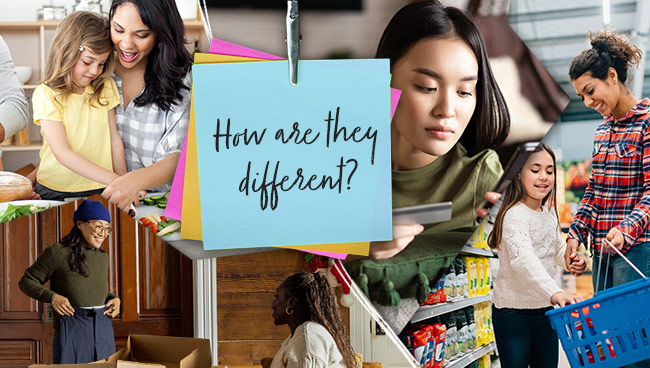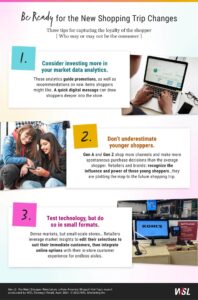All shoppers are consumers, but not all consumers are shoppers. Are retailers and brands making the proper distinction? In exploring what distinguishes these two groups, we also unearth through market research just how much shopping, not consumption, has changed – and how retailers can keep up.
Are You Treating Your Shoppers Like Consumers?
There is an important difference between shoppers and consumers that not all brands and retailers may recognize. Notably, the behavioral trends that help one influence the other.
Here’s the rule of thumb on telling the two groups apart: Shoppers are your in-store and online visitors who purchase your goods and brands. The consumer, meanwhile, is the person who ultimately uses those goods – who eats the foods, wears the clothing or takes the medication purchased by the shopper.
The consumer can be a 5-year-old child, your partner who never enters a store, a sick-at-home family member or friend coming for dinner.
There is overlap, of course, because many shoppers are also consumers and many end consumers shape shopper decisions. Kids, for example, influence the purchase choices of nearly 90% of parents[1], especially in categories that are kid-focused (like cereal). Consumers, like shoppers, also research products and prices and compare retailers and brands.
So they’re educated influencers, but when the buying decision is made, they’re often absent.
Consumption is the Same, Shopping Has Changed
Here’s the tricky part: The “role” of the consumer hasn’t dramatically changed over the generations, because consumption itself hasn’t much changed. We still eat peanut butter with a spoon (right?) and put socks on our feet (right?).
However, the act of shopping for peanut butter and socks – that has changed, dramatically. And the differences in how such items are shopped, versus unpacked and consumed, keeps multiplying thanks to digital tools and a widening breadth of options and alternatives, from the physical shelf to direct-to-consumer websites.
Consider just these four behavioral preferences, which can affect retailers’ sales, based on our How America Shops® research:
Shoppers will find a way to get “it,” whatever it is, now.
The average number of channels shoppers use has risen sharply since 2014 – to nearly 12 from 8.7. As a result, customers expect to buy whatever they want, whenever and wherever they want, including through social media like Instagram and livestream events. Beach balls in February? No sweat, thanks to Amazon. And not just plain beach balls – you can find them filled with glitter, adorned with unicorns and glow-in-the-dark options.
Curbside pickup is carving new in-store paths to purchase.
One-third of online customers end up running into the store to do more shopping after picking up their orders at the store. Sometimes these trips are for items forgotten in the order, sometimes consumers use the time saved shopping for the basics online to browse whatever they feel is a “fun” category. These trips into the store can result in unplanned purchases, thanks to strategically placed goods that always fill a need – think beverages, baked goods, flowers and of course, candy.
How shoppers “check out” what’s in store is different.
During the pandemic, more than four in 10 shoppers said they wanted retailers to add more self-checkout lanes[2]. Retailers have, and as a result shoppers have since been conditioned to look for goods in new places. Remember those tall cooler cases by the register? Well, at self-checkout those coolers and other goodies are tucked under the register. Shoppers don’t look up for a last-minute treat; they look down.
What has not changed is the curiosity to try new products.
We may think new products are discovered while browsing the internet, but two-thirds of shoppers told us in WSL’s “Planned Disruption” report that they discover new products in the store when browsing the shelves and product displays. The point: Brand and category curiosity is something only the shopper experiences, and it’s the shoppers, not consumers, who are in stores.
Be Ready for the New Shopping Trip Changes
Here are three tips for capturing the loyalty of the shopper, who may or may not be the consumer.
1. Consider investing more in your market data analytics.
Sophisticated consumer insights that result from culling through various streams of data (from social media to shopper surveys) can provide a more accurate reading on who the shopper is buying for. These analytics guide promotions, as well as recommendations on new items shoppers might like. A quick digital message can draw shoppers deeper into the store, which is the goal of every retailer that offers in-store pickup.
2. Don’t underestimate younger shoppers.
Gen A and Gen Z adults, who now range in age from their teens to mid-20s, shop more channels and make more spontaneous purchase decisions than the average shopper[3]. They also shop the same major chains as older shoppers (yes, like Walmart) and agree that they discover something new while in these stores. Retailers and brands should recognize the influence and power of these young shoppers, because they are plotting the map to the future shopping trip.
3. Test technology, but do so in small formats.
As our recent Retail Safari® revealed, more big-format merchants are reaching shoppers in important, dense markets, but in small-scale stores. These retailers, including Bloomingdale’s and Kohl’s, leverage market insights to edit their selections to suit their immediate customers, then integrate online options with their in-store customer experience for endless aisles.
We Can Answer Many Questions for Retailers and Brands
Need to know more about the differences between shoppers and consumers, the research methodologies we use at WSL and how to identify new category growth opportunities?
Visit our FAQ page on our newly designed website. Catch up on our Retail Safaris® and Retail Innovators here.



